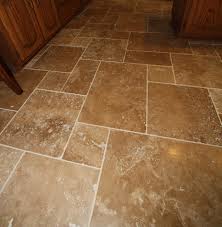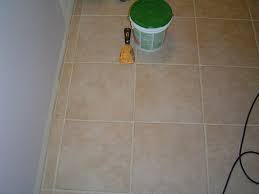Ceramic Tile and Travertine Tile each have their own Unique Pros and Cons
By Mark J. Donovan
|
|
Ceramic tile versus Travertine tile is a common question for many homeowners. Each have a number of unique advantages over the other, but the bottom line is application and cost. Ceramic tile is a man made product that is relatively easy and inexpensive to produce. Travertine tile on the other hand is a naturally made material which is more expensive.
Ceramic tile, and particularly Porcelain tile which is a form of ceramic tile made from more refined material, holds up very well to staining. |
Ceramic tile with a glazed surface is particularly resistant to stain. Travertine tile on the other hand is more sensitive to staining.
Travertine tile, versus ceramic tile, is a naturally made stone material. Due to the fact Travertine tile starts from a quarry, and that there is a finite amount of it on the earth it is a more expensive tile option. Travertine tile has been used for thousands of years and because of its history many homeowners prefer it to other tile types. This said, Travertine tile is a form of limestone and is such very porous. Consequently it is susceptible to stain and moisture. As a result, Travertine tile, versus ceramic tile, may not be the best choice for a bathroom or heavily used kitchen. On the other hand, it is ideal for hallways, great rooms, and low traffic kitchens.
| Travertine stone tile is available in two main types, natural/tumbled and honed. Natural, or tumbled Travertine tile, is left more in its original state and thus has a more rustic and grainy type appearance. Honed Travertine tile is more similar to ceramic tile in appearance. Honed Travertine tile is polished to a smooth finish and is more appropriate for kitchen and even some bathroom applications as it is a little less likely to absorb stains.
Travertine tile is available in all sorts of shapes and sizes, however its colors are somewhat limited to more earthy tones, such as beige, gold and reddish colors. The amount of iron in the Travertine tile dictates its color. |
 |
In regards to maintenance Travertine tile should be sealed regularly to mitigate the risk of staining and water penetration. Ceramic tile should also be sealed periodically but the frequency does not need to be as often.
Ceramic tile, versus Travertine tile, is a manmade product that is constructed out of clay, quartz ferrous sand materials, and water. Ceramic tile is constructed using red, brown or white clay, whereas porcelain tile is constructed using white clay. After the ceramic tiles are molded into shape they are fired to high temperatures, and in some ceramic tile types their surfaces are glazed.
Check out this review on Duraceramic floor tiles.
| The key difference that separates Porcelain tile from regular ceramic tile is that the clay used in porcelain tile is of a more highly refined and purified nature. As a result, porcelain tile is much denser and more rugged than standard ceramic tile, however it is slightly more expensive than ceramic tile, but less than Travertine tile.
Ceramic tile is available in both glazed and unglazed surfaces. Glazed ceramic tile surfaces are similar to glass and are best used on walls as they are much too slippery for floors. |

Learn how to tile a floor. |
Glazed ceramic tiles are also a bit more susceptible to cracking and thus another reason why they should not be used on floors.
So the bottom line when it comes to the ceramic tile versus Travertine tile debate is deciding upon expense, application and personal aesthetics. Both Travertine tile and ceramic tile have been used for thousands of years, and each are available in a wide assortment of shapes, sizes and colors, including ornate mosaics. It’s hard to go wrong with either tile type as long as you keep up with the proper maintenance.
So when making the porcelain tile versus Travertine tile decision consider how the tile surface will be used, as well as the appearance you are looking for. If, for example, you plan to tile a wall surface then there is less likelihood of spills and staining to worry about, so Travertine tile may be your preferred choice. If on the other hand, you are considering a tiled kitchen floor and you have pets and small children then staining is a major threat and thus Porcelain tile may be a better choice.
For information on installing a shower pan membrane liner for a ceramic tile shower, see the Shower Pan Membrane Liner Installation Ebook from HomeAdditionPlus.com. The Shower Pan Membrane Liner EBook will quickly teach you the step-by-step process for installing the shower pan membrane liner correctly. It includes instructions on framing the shower stall, pouring the pre-slope and shower base mortar, and installing the shower pan membrane liner.
See HomeAdditionPlus.com’s Ceramic Tile Calculator
See my “How to Tile a Custom Ceramic Tile Shower” Ebook to learn how to tile your own shower: For a detailed set of instructions on tiling a shower floor and walls, including pictures for every step in the process, see my “How to Tile Custom Ceramic Tile Shower Ebook”.
Related Information
- Porcelain versus Travertine Tile
- Floor Tile Underlayments
- Ceramic Tile Flooring – The Healthy Choice
Additional Ceramic Tile Resources from Amazon.com
 |
 |
 |
Get Free Bathroom Remodeling Price Quotes with No Obligation!
Fill out our 3-5 minute quick and easy form, and receive a free price quote on a bathroom remodeling project from one of our pre-screened and licensed bathroom remodeling contractors. This process is free and there is no obligation to continue once you receive your bathroom addition price estimate.
